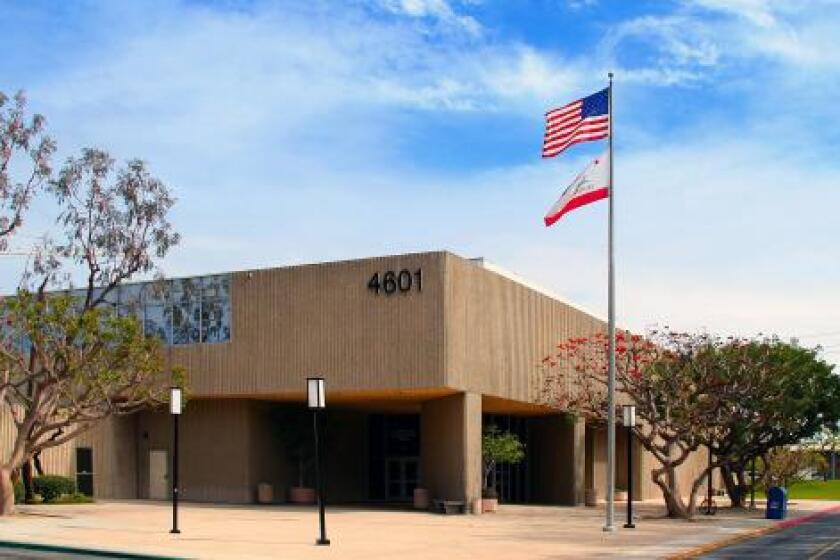Impending cataclysm is no reason to stop enjoying life
- Share via
VIC LEIPZIG AND LOU MURRAY
The National Geographic and Discovery channels have been running
specials on the topic of super volcanoes. The focus of the two shows
is the Yellowstone Caldera, which erupted violently 2.1 million, 1.3
million, and 640,000 years ago. The premise of the show is that
Yellowstone is overdue for an eruption and may about to blow again.
That’s very exciting and scary, but most geoscientists believe
that Yellowstone is in a late phase and that the tectonic plate has
already passed over the hot spot that would result in another
cataclysmic eruption. They believe the area of Billings, Mont., might
be the site of a future mega-eruption, but that it may be millions of
years before that happens. We’re going with this more conservative
view.
There is no doubt that Yellowstone, like California, is
geologically active. Interestingly, the ground beneath Yellowstone
Lake has been rising slowly on the north end, causing flooding at the
south end of the lake. Generally this type of earth movement is
associated with an impending blowout of some sort. Hence the dramatic
fear-mongering on TV, which seems to promise an eminent
super-volcanic eruption.
Maybe someday such an explosion might occur. But just when or
where or what the magnitude might be, no one can say, because
volcanoes are not that predictable.
Super volcano is not a technical term, but was coined by
television producers. Suffice it to say, the effect would be huge.
The eruption of a super volcano in the Yellowstone Caldera would bury
half the U.S. in deep layers of ash. The weight of volcanic ash would
crush buildings and kill thousands, if not millions, of people. The
ash would float into the upper atmosphere and reverse global warming
in an instant. The outcome would be a phenomenon known as volcanic
winter, similar to what would be expected following a massive atomic
explosion or gigantic meteor impact.
The ash from a super volcano would block sunlight from reaching
earth, chill the planet for decades, dramatically affect plant growth
and cause extinctions either directly or through long-term climate
change. Economies would collapse. Some scientists believe that the
ensuing years of volcanic winters from the eruption of a super
volcano would obliterate agriculture as we know it and even threaten
survival of the human race. In comparison, eruptions of regular
volcanoes cause global chilling that lasts a year or two.
The potential for a super volcanic explosion lurks much closer to
home than Yellowstone. The eastern Sierras around Mono Lake have been
erupting off and on for millions of years. This area is considered by
many experts to be the most likely place for a future eruption in
North America. If you drive to Lee Vining, like we did last week,
you’ll pass many old lava flows and cinder cones, as well as active
hot springs and steam vents.
The Long Valley Caldera was created by a gigantic eruption about
760,000 years ago. That big blowout sunk an oval depression into the
ground south of Mono Lake that was 10 1/2 miles long and 20 miles
wide. The resulting sinkhole was a mile deep. Like the Yellowstone
Caldera, the Long Valley Caldera was created by ground collapsing
into a void that had formed over hot magma. The result was a blowout
that shot 150 cubic miles of super-heated ash into the air. Fallout
of ash reached as far as south as present-day Huntington Beach, and
as far east as Nebraska. For comparative purposes, Mt. St. Helens
blew out a mere quarter of a cubic mile of ash.
With volcanic ash fallout reaching temperatures of 1,400 degrees,
all life within many miles of a super volcano blast would be
instantly annihilated. When the Long Valley Caldera blew, it covered
the surrounding area with 600 feet of volcanic ash, and the intense
heat of the blast fused the ash into a type of rock that is known as
Bishop Tuff.
Like Yellowstone, the eastern Sierras have shown signs of
impending eruption, but impending is relative when it comes to
volcanoes. A series of strong quakes associated with dome-building
shook the Mammoth Lake area in 1980. Disaster seemed imminent,
especially if you listened to the TV newscasters who make their
living by keeping the public on edge about impending disasters.
Twenty-five years later, the most noticeable effects have been a
dome-shaped bulge on the caldera floor, tree-killing carbon dioxide
seeping from the soil around Horseshoe Lake, and swarms of quakes
around Tom’s Place south of Mammoth Lake. You can read more about it
at https://lvo.wr. usgs.gov.
If you’re curious about how often and where the earth moves in
California, you can monitor the hundreds of earthquakes that occur
every week by logging on to https://quake.usgs.gov/
recenteqs/latest.htm. This site shows all the California temblors in
the last week in live time, with size, magnitude and location.
We usually log on when we feel a jolt just to see how well we
guessed the magnitude and location of the temblor. The rest of the
country laughs at us. Guess it’s a California thing.
The bottom line on end-of-the-world mega-disasters like super
volcanoes, giant meteors and nuclear winters is that they’re not very
likely to happen. We can’t stop taking care of our health, our
everyday lives or the environment just because something cataclysmic
might happen sometime in the next million years.
The best thing to do about a super volcano is not worry. Continue
protecting our environment, soak in those mineral hot springs, and
don’t be concerned about the magma below.
* VIC LEIPZIG and LOU MURRAY are Huntington Beach residents and
environmentalists. They can be reached at [email protected].
All the latest on Orange County from Orange County.
Get our free TimesOC newsletter.
You may occasionally receive promotional content from the Daily Pilot.



